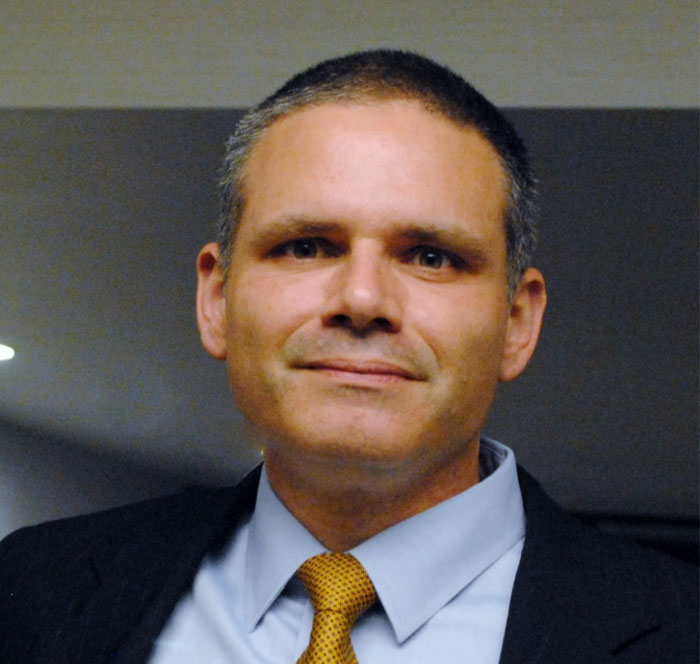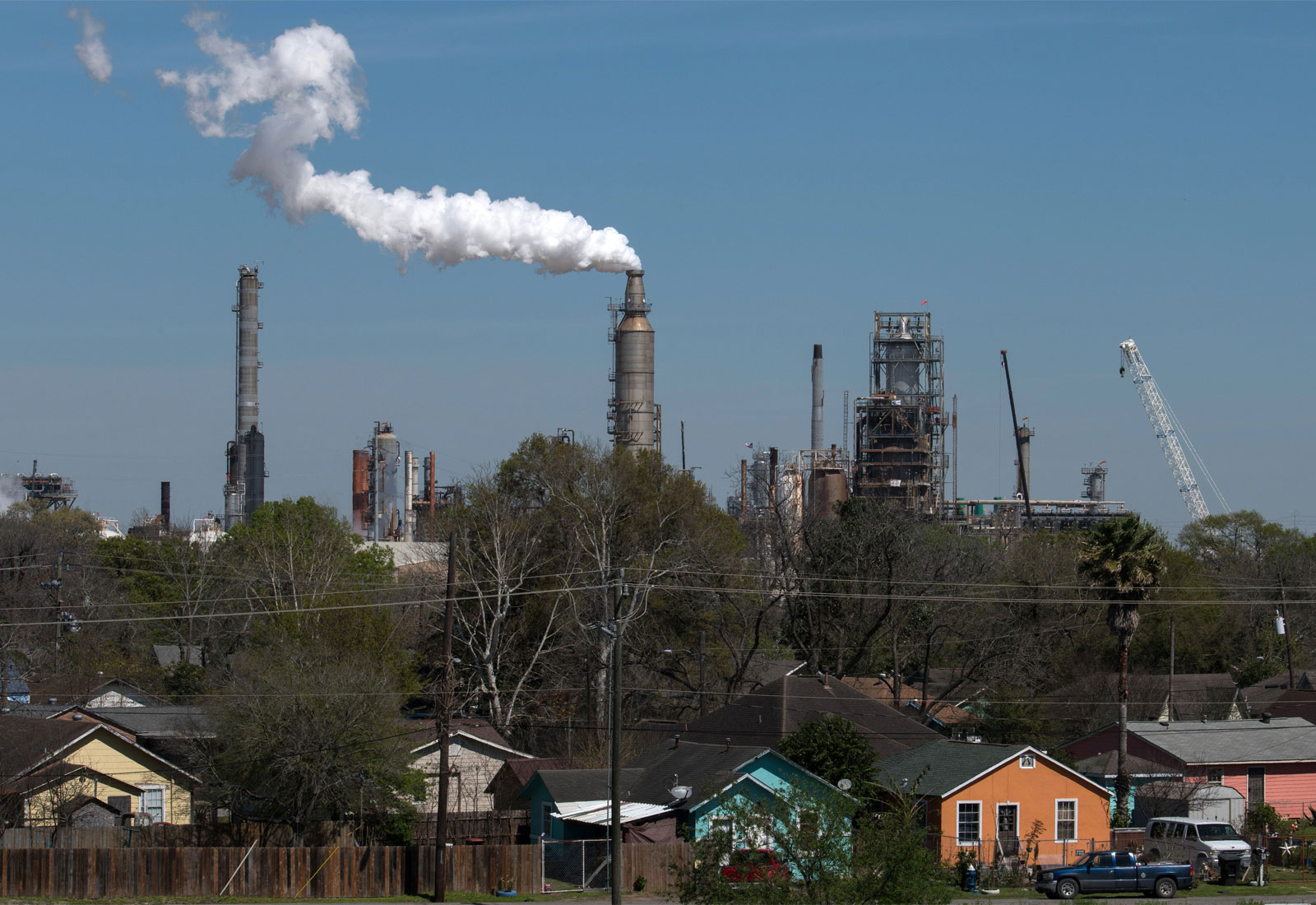In 2013, Matthew Tejada joined the EPA as director of the Office of Environmental Justice, or OEJ, overseeing environmental justice work both across the agency and also in partnership with other federal agencies. One of Tejada’s primary responsibilities is to engage with, listen to, and advocate on behalf of communities disproportionately burdened by pollution and environmental degradation.
Tejada arrived at the EPA from Houston, Texas, where he served as executive director of Air Alliance Houston, a nonprofit environmental advocacy group that tackles environmental justice issues in the Gulf Coast area. The Houston region is plagued by some of the worst pollution in the country and is the largest petrochemical hub in the U.S. For decades, low-income people of color have lived in toxic zones near massive petrochemical plants, oil refineries, and the shipping industry, and have suffered from exposure to harmful pollutants on a regular basis.
Having now spearheaded the EPA’s environmental justice efforts under three different presidential administrations, Tejada sat down with Grist for a 30-minute interview to discuss implementing President Joe Biden’s environmental justice agenda, the difference between working inside and outside government, and how to direct resources to the most vulnerable communities.
This interview has been condensed and edited for clarity.

Q. What is the role of the Office of Environmental Justice?
A. It was about four or five months after I got here back in 2013 when I was still kind of like, “Oh my gosh, how did I get this job?” And then it hit me: EPA basically hired me to run the same sort of shop that I was already running. It’s just inside of the government. Because the OEJ and the EJ program is essentially a small advocacy group that just happens to be inside of EPA, and that means we have to operate within the bureaucracy.
We don’t have the authority to tell anybody what to do, because we don’t have a statute that allows us to do that. We’re typically much smaller than all the other people we’re trying to influence. We have almost no money, and they have all the money. It’s almost the exact same proposition as running a community-based organization on the outside, but we just happen to be on the inside. And that’s actually kind of the philosophical framework that we have adopted inside of the EJ program. When we get new folks into the program, we’re developing training for them to operate as advocates, because that’s essentially what we do: We advocate for EJ on behalf of the communities on the outside, trying to elevate or project their voice into the building whenever we can.
Q. What were the lessons you learned from the process of addressing air quality and public health issues at that community level in Houston that you’ve applied to your work within the EPA’s Office of Environmental Justice?
A. One of the most important things I learned in Houston, after I had walked away with some bloody noses a few times, is something that we follow on the National Environmental Justice Advisory Council, or NEJAC: Everyone’s got to be at the table, and that includes the folks you are fighting against. That includes the folks that you’re not getting along with. That includes business and industry. That includes those local institutions like a port, or like a school district, or like a hospital district. You’re starting from a place of: Let’s find something we can start to work on together and build out from there. I think of Houston as a microcosm.
You need all the parties at the table, but that table is always centered on the community need, with everyone arrayed around it. And the work, and the relationship-building, and the accountability it takes to keep people at that table while you find those things that you can work on together is tough. It’s a tough thing to learn how to do, and it’s a tough thing to do well. But once you figure out how to do it, then you can really start to see some progress get made.
Q. Can you discuss how those approaches have played out throughout your tenure at the EPA?
A. When I got here, I already had heard about EJSCREEN [the EPA’s Environmental Justice Screening and Mapping Tool]. Back in 2010, I was already writing grant proposals in Houston to use this new tool that didn’t even have a name yet, because I’m a huge believer in the transparency of data. And when I got to EPA, I was very excited that that was going to be one of the things I got to do — work on this tool finally and get it out. I wanted to get it out the door, because I wanted everyone else to have this tool. And we did a lot of work as soon as I got in to get it ready to get out the door.
I thought it was a no-brainer that we were just going to pop that thing right out. And somebody said, “Well, let’s go ask the states.” And it took a solid year of working with states and understanding their concerns and alleviating their concerns through more work and a lot of collaboration. As painful as that whole experience was for me, it was a better product and a better release by the time we finally got it out. And that was a huge learning experience about the need for everyone to be there, the need for everyone to be involved. So that was a huge learning experience — and something that I think has been instrumental in driving environmental justice conversations across the United States over the last six, seven years.
Q. How have you tapped that data to narrow down or focus on the communities that are the most disadvantaged or the most vulnerable?
A. What is happening now, especially with Justice40 and executive order 14008, is the president is taking that same data and using that data and that visualization ability to drive the decisions, or even base the decisions, on that data. That is a huge leap forward. We’re starting with resources. We’re going to start reallocating resources potentially based upon a map of inequity across the United States. People talk about moonshots all the time, and that’s cliché. I’m not saying this is a moonshot, but this is a big deal. That is a big mandate that the president laid out for the whole government.
Q. Can you discuss the work that your office has done this past year to address the concerns raised by environmental justice advocates when the EPA decided to relax the enforcement of the country’s environmental protection laws due to the COVID-19 pandemic?
A. In terms of what the agency’s response to COVID has been, I don’t have a lot to say about what the last administration did. We were not involved, advised, asked. We didn’t even know where the door was to knock on to see if we could have input into what happened on that in the last administration. I will say, the thing we’ve been excited about in this administration with the American Rescue Plan funding that we received from Congress is that that was $100 million dollars to answer some of the most pressing needs that we have heard for decades. We finally were given some resources to start resourcing those needs across the entire United States. I’m really proud of the work that the whole agency did to find existing contracts, ready-made grant vehicles, so that we could look across the entire United States — including Indian country and tribal lands, including noncontiguous areas of the United States, especially a lot of focus in Puerto Rico and the Caribbean — and find different ways to get that money out on the ground as quickly as possible.
We gave a big chunk of money to our enforcement folks, because there were hot spots across the United States that we simply did not have the money at EPA to be able to monitor. So I think our response, the response of this administration and the really clear direction that the administrator gave right off the bat — we’re going to use this for environmental justice, it’s going to get out to the places where the community needs it the most, and we’re going to do it as quickly as possible — has been our guiding star for using that money.
Q. You raised the Justice40 initiative early on in the conversation. One of the concerns from environmental justice advocates has been around the distribution and selection of these communities, and whether the benefits of these investments will reach truly disadvantaged communities who may not be at the table right now. How do you ensure diversity in how this will be implemented?
A. From EPA’s perspective, one of the things that constantly comes up is the need for technical assistance in capacity building. I think there’s a huge recognition out there that the volumes of money, the redirection of that money to really get to the communities that need it the most — there’s a big hole in the middle of that idea, because you’re talking about community organizations and their local partners — rural towns, tribal governments — who just don’t have the capacity to compete for that money or to use that money to its fullest extent once they get it. There are layers and layers of capacity building and technical assistance that need to happen right now in preparation for these monies to start to be redirected or for these other monies that Congress might appropriate in the coming days and weeks. And that’s something we’re focused on.
Q. President Biden has discussed addressing environmental justice through an all-of-government approach. Are there any specific environmental justice issues that are at the top of the priority list for your office this year?
A. We’re working our butts off implementing all of the president’s executive orders. Just implementing those executive orders is a huge priority. This is the most exciting moment I think any of us have been through inside of the government. But having been through lots of moments, we always have one eye looking downfield for the next moment. How can we use this moment to propel us into and through those future moments to make things stick, so that things don’t backslide, to make things transparent, make things accountable? Not just for the EJ program, and not just for the leadership of the agency, but for everybody at the agency. Those are big priorities for us as we move through all of this work.



